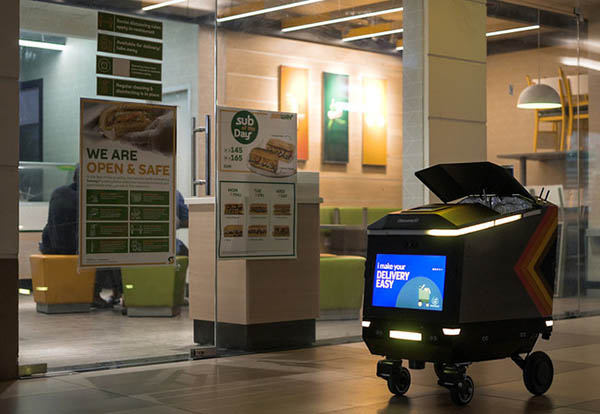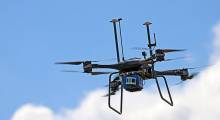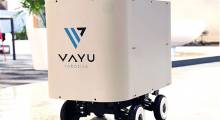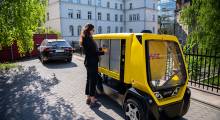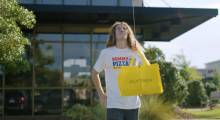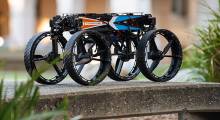Staffing shortages, accelerated e-commerce demand, and the need for contactless service are driving demand for delivery robots. While some robotics developers are focusing on indoor deliveries and others on outdoor operations, Ottonomy Inc. is testing robots for retail and food delivery in both environments.
Santa Monica, Calif.-based Ottonomy said its autonomous mobile robots (AMRs) use proprietary contextual navigation software that enables them to navigate both indoors and outdoors. The robots also include multi-layered safety protocols to facilitate safe navigation in crowded spaces such as sidewalks and airports.
The company claimed that its systems, which are available through a robotics-as-a-service (RaaS) model, can contribute to sustainability and scalability goals.
Ottonomy last month partnered with Los Angeles-based CraveUp so that consumers could use CraveUp's mobile app to order robotic deliveries in food courts in California.
Mapping and processing for dynamic AMRs
“AMRs are mostly focused on constrained environments like warehouses,” said Ritukar Vijay, CEO of Ottonomy. “We have experts in both indoor robotics and outdoor autonomous driving. Localization of our delivery robots is not dependent on GPS, so for us, indoors versus outdoors doesn't make a difference.”
“Ottonomy splits mapping in a unique way,” he told Robotics 24/7. “We take the geometric map and then add contextual information to it. That's not the case in most AMRs or self-driving vehicles.”
Ottonomy teleoperates its robots for the initial mapping, and then its robots can run autonomously.

“We use compute at the edge for localization and mapping, which are very processor-hungry processes,” Vijay explained. “We have a proprietary implementation that uses GPUs for visual processing and the rest on serial. We're also moving planning onto GPUs for smoother trajectories next to people.”
“On the surface level, that seems easy enough to solve, but for compute for dynamic environments, you need to plan two- to three-digit trajectories,” he added. “We're also part of NVIDIA's Inception program for AI startups.”
Ottonomy develops for full autonomy
“The first MVPs tested our systems November-December of 2020,” said Vijay. “The robots didn't have full teleoperation, but they had wireless e-stop [emergency stopping]. There was not one instance of needing it.”
“At the same time, we realized that for safety and regulatory compliance both indoors and outdoors, we need full-fledged monitoring and control,” he noted. “Our network operations console gives an entire view of the fleet and each robot's journey, including the entire cycle of order to pickup and waiting.”
“It also provides insights such as the number of orders per hour and analytics,” Vijay said. “We can see the position of all robots in a live map, but the robot just sends alerts when it needs help. Then it triggers our monitoring system, and teleoperation can kick in.”
“Other delivery robot companies are following an incremental approach, but as with autonomous driving, it's tricky because the safety driver has to be continuously alert,” he said. “We're moving way from that, with autonomous robots that call only when necessary.”
“If the goal is to be 100% autonomous, you need multiple sensors—3D lidar, cameras, and safety sensors,” added Vijay. “If you're relying just on deep learning, systems can be 70% to 80% autonomous, but then it's harder to go back and make changes.”
“Between 45% and 60% of robotics companies are fully teleoperated and claim they'll eventually have autonomous functionality,” claimed Vijay. “If we look ahead two to three years to reach autonomy, it will still take them time to make unit costs. We're at that point right away, which is a massive difference.”
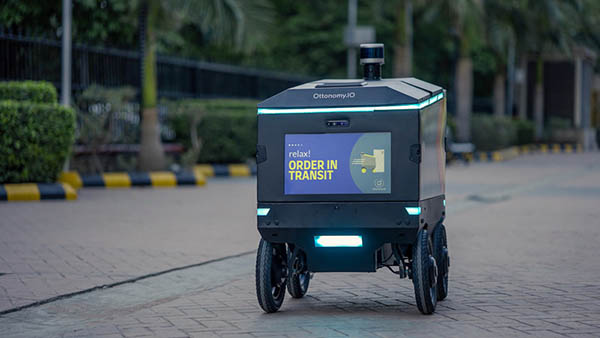
Indoor vs. outdoor operations
“The first difference for outdoor environments is our sensor choices,” Vijay said. “Thanks to our fleet management, mapping is decentralized. Five robots can communicate with one another and create or update a map of an area.”
“The second from a use-case perspective,” he said. “We're focusing more on bringing orders from inside a store to curbside. The amount of online digital ordering—70% are pickups, and 30% are doorstep delivery, particularly for groceries. We looked at what needs to be solved for both environments, and there are no state regulations for curbside, unlike last-mile deliveries, which could push nationwide scaling years out.”
In addition, Ottonomy's robots have multiple compartments for greater productivity and sustainability. “They can carry two distinct orders in a single trip, for higher throughput,” said Vijay. “From an urban planning perspective, it's better to have fewer robots delivering more orders.”
“For example, there might be 75 orders for pizza between 6:00 and 8:00 p.m.,” he said. “You'd need 75 trips with a standard robot; we can cut it by 50%.”
RaaS and partnerships
The RaaS model can provide immediate benefits for restaurants and retailers, said Vijay. “We keep the barrier of entry low—the more they use the systems, the better,” he said. “Post-COVID labor costs have increased substantially, from $9 per hour to $15 per hour, to $19 per hour by 2022. Labor is not coming back.”
Another benefit of the service model is that data sharing is clearly defined. “Operational data stays with us, and we can share it with partners,” Vijay said. “We have two kinds of partners: One is the ordering apps, and the second is point of sale.”
“Some companies have attempted to create their own delivery apps with their fleets of robots,” he observed. “We just want to enable restaurants to provide more levels of delivery; we don't want to compete with existing apps.”
“The ordering apps are helping us to scale and to bring compliant systems to market,” he said. “A single app could have multiple robot vendors.”
On the point-of-sale [PoS] side, a restaurant can decide which service is cheaper—they might pick DoorDash or Nuro for farther orders. There's a lot of innovation. We're integrating with two large players that will help orchestrate with a large number of restaurants.”
How does Ottonomy position its robotic delivery service with partners? “For the large chain restaurants or retailers, it's done directly by us, but in the case of a food court, we go to a single point of contact,” said Vijay.
Ottonomy moves from demo to actual deliveries
“We demonstrated that our robots were capable of navigating in a dynamic environment at the Cincinnati airport in November 2020,” recalled Vijay. “The robots were able to react to pets and even a kid lying on the floor crying.”
“We're a few months away from product launch and are now working on longer range,” he said. “It's now two miles, and the operational range depends on the speed of the order at 1 to 1.5 mps or 3 to 3.5 mph. Regulations allow robots to move up to 10 mph, but when the robot is on a busy sidewalk, it would have to slow down.”
“We conducted a poll about robot deliveries,” Vijay said. “Many wanted Level 4 autonomy, but more than half are still teleop. We also asked what normal users really wanted delivered. Fifty percent said e-commerce orders, then groceries, and then on-demand food delivery. That changes your perspective.”
“The market is really accepting our timing and capabilities,” he said. “Because of our focus on autonomy, Ottonomy is not a typical mobile robotics company.”
About the Author
Follow Robotics 24/7 on Linkedin
Article topics
Email Sign Up

